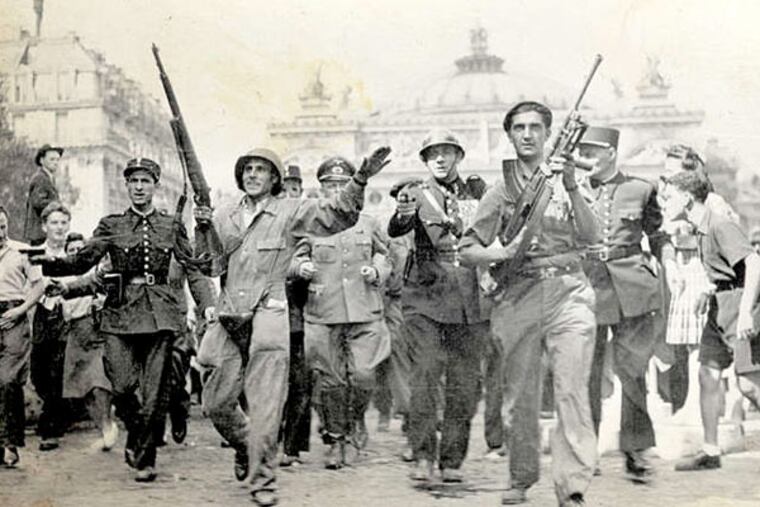Throwing off Nazi yoke
Legendary World War II correspondent Ernie Pyle felt he had seen it all, and "I had thought that for me there could never again be any elation in war. But I had reckoned without the liberation of Paris."

The Blood of Free Men
The Liberation of Paris, 1944
By Michael Neiberg
Basic Books. 352 pp. $28.99
Legendary World War II correspondent Ernie Pyle felt he had seen it all, and "I had thought that for me there could never again be any elation in war. But I had reckoned without the liberation of Paris."
Quoted toward the end of Neiberg's riveting account of a generally neglected subplot of the war, Pyle observed how the citizens of the city, with minimal help from Allied forces, threw off the yoke of Nazi occupation with what Albert Camus described as "the blood of free men."
The short version goes something like this:
German forces occupied Paris on June 14, 1940, and eight days later, an armistice was signed between Germany and France setting up the collaborationist Vichy government headed by World War I hero Marshal Philippe Petain.
For the next four-plus years, Parisians suffered from shortages of food and other essentials, disease, violence from occupying forces against Resistance members real and imagined, and a host of minor indignities.
But physical damage was limited. Ironically, it was caused mainly by Allied bombers targeting the transportation and industrial infrastructure of the city and surrounding areas. Thousands of Parisians died in these raids as Nazi forces took shelter in the Metro while keeping city residents out. Most of the city, however, including its historic and cultural treasures, remained essentially untouched.
Then, when the Allies landed in Normandy in June 1944, the picture changed. It quickly became apparent that the leading American generals, Dwight D. Eisenhower and Omar N. Bradley, were mainly interested in establishing a beachhead, seizing key ports such as Cherbourg and Antwerp, and then striking inland toward Germany over a route that bypassed Paris. To them, Paris was a diversion that could delay the Allied advance. They also didn't welcome the prospect of feeding the population. Pro-intervention arguments by French military leaders, mainly Generals Charles de Gaulle and Philippe Leclerc, were unavailing.
What alarmed the generals and the Parisians was the prospect that the Nazis, perhaps following orders from Hitler, would devastate the city. The Nazi commander, Dietrich von Choltitz, had already played a key role in the destruction of Warsaw in Poland and Sevastopol in Ukraine.
Von Choltitz, however, turned out to have little appetite for destroying Paris. He knew the war was lost, he knew that Hitler had become a raving lunatic, and he knew that his troops were not equipped for the urban guerrilla warfare that all-out combat against the locals would set off. He also wanted to preserve what remained of the city's transportation infrastructure for strategic purposes.
What did set off the street fighting of August was a strike by the Paris police, which had kept order on behalf of the Nazis and the Vichy government. The police - or large numbers of them, anyway - switched sides after the Normandy invasion and joined the Resistance. Until then, the Resistance had been led by the pro-communist Forces Francaises de l'Interieur. FFI leader Henri Rol-Tanguy had said the liberation of Paris was worth 200,000 dead, a sentiment that was hardly shared by de Gaulle and other centrists, who had hoped to avoid major violence until the Allies could intervene in force.
In the end, of course the Allies did arrive - Eisenhower had finally come to fear the city's destruction - and the Germans retreated in semi-disorder, allowing de Gaulle and Leclerc to lead the triumphant freeing of the city. De Gaulle, cementing the growing legend that made him France's unquestioned postwar leader, calmly went from the victory parade to a religious ceremony at the Notre Dame cathedral as snipers' bullets - no one knows from where - whizzed about him.
Neiberg, a professor of history at the U.S. Army War College in Carlisle, Pa., is especially adroit in charting the course of French politics in the mid-1940s, because the battle for Paris was not only a battle for the city itself, but also a battle over who would lead the country after the armistice.
De Gaulle, he says, feared civil war in France almost as much as he feared the Germans. He and other centrists were reluctant to see the freeing of Paris as a communist triumph. But they also did not want to see a takeover by conservative elements, including Vichy sympathizers, or a reaction against them rivaling the French Revolution's Reign of Terror.
Perhaps the two most intriguing figures in the saga are de Gaulle, who started the war as a relatively obscure general in exile in London, and Raoul Nordling, the Swedish envoy in Paris, who mediated between the Nazis and the Resistance until the Allies arrived.
One wishes Neiberg had had the space to tell their parts of the story in even greater detail.